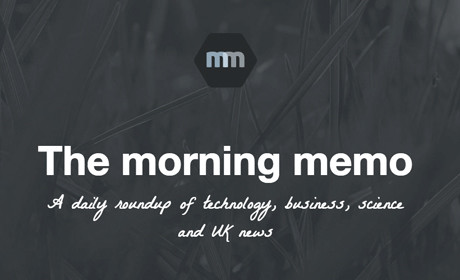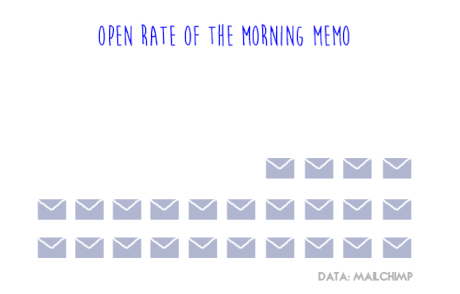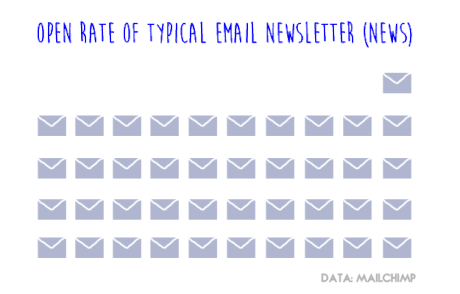
The Morning Memo ended yesterday.
Six months ago, I got together with a bunch of journalism students from City University and started sending an email, The Morning Memo, every weekday to a mobile-first audience interested in news about technology, science, business and the UK.
We sent it for six months and achieved an average open rate of 53 per cent. By way of comparison, the typical email newsletter related to news has an open rate of 18 per cent, according to Mailchimp.


Images courtesy of Siraj Datoo
We must have done something right.
When we launched, the most interesting conversations about newsletters were in the US. Digg have been sending out a newsletter based on social activity for years while Quartz’s Daily Brief has become something of legend.
Meanwhile, in the UK, daily emails are often sent from news publications with links to their own site. Those emails serve a specific audience well – it’s just not something that we found particularly fascinating.
But what if a newsletter has a less formal premise and looks more like a good Twitter feed – interesting links to wherever they’re from?
Although it was never mentioned, and as we come to a close, that’s what the Memo was: essentially a well-curated Twitter feed that appeared in inboxes every day.
Very sad to see @themorningmemo email stop. Always had something to interest, inform or delight.
— Robert Colvile (@rcolvile) July 14, 2014
So why do we think people came back for more? Here are our key take-aways from the experiment:
1. Obsess over the data, change things. Rinse and repeat
The first lesson shouldn’t come as a surprise. Data is crucial when it comes to newsletters so anyone sending one should use a provider that makes it easy to monitor changes in subscriber numbers, the open rate and what people click on. The email provider should also let you easily check whether subscribers are regular readers.
We used Mailchimp, which let us do all these things although checking for loyalty was a little fiddly. We also didn’t consider the click rate to be crucial for us – we were providing a brief summary of things that others had written – but it was useful to understand what readers found interesting enough to click and also how far down the email they read.
We found that links that appeared in either the very first or very last section of the Memo – a brief recap of the latest news and links to things we found interesting respectively – were regularly amongst the most-clicked links each day. This put some pressure on us to find particularly interesting links for this section, which arguably led to a better newsletter.
Today's @themorningmemo linked to our Instagram vids with a question – suddenly 2nd most clicked link pic.twitter.com/6MkOCgsmSE
— Kadhim (@kadhimshubber) May 30, 2014
It’s fair to say that we did use the data to learn about better phrasing. We found that when asking people to view our alternative video, rather than just linking to it, the number of clicks dramatically shot up.
2. Being conversational gives personality to your email – and that’s likely to increase user feedback
We were proud that all the words in the newsletter were written entirely by us and not automated. We didn’t have to care about search engines, just about humans; and this let us write a concise but, hopefully, engaging email.
It took each of us a little while to find the right balance between informal, casual and conversational (too much sass or sarcasm can be off-putting) but it gave us flexibility to not be so rigid in our approach.
The Telegraph’s morning political briefing, for example, sets itself a deadline of being sent by 8:30 am each day, before Downing Street’s first meeting.
We preferred to send out an email at 8am, to reach inboxes around the time that many are commuting to work so they can easily read it on their phone. But sometimes we were late and that was okay.
Of all the daily briefings, @themorningmemo is the most adorable pic.twitter.com/PgDrKf1yea
— Tara Mulholland (@tara_mulholland) May 8, 2014
Another element that a conversational tone adds is personality. We were especially late once; the editor for the day’s alarm hadn’t gone off and was bluntly honest about it. The email began: “Sorry about the delay today, we may have overslept.” In response, we were called “adorable” and got a great new line for our Twitter bio.
We found the conversational tone meant readers also treated us more like a friend, or at least somebody with whom they were comfortable. One day we sent a briefing in the afternoon as a test and got a rather sassy email in response: “I’d rather not receive the MORNING Memo in the afternoon, thanks.” And any direct, uncalled for, feedback is great.
3. Don’t be afraid to be fun. People like GIFs
Serious news is important. It’s the stuff that’s happening around us, and people need a way to keep in touch with the huge amount of information headed in their direction. It’s inevitable that we all miss something, especially if something happens in an area we don’t follow, and that’s a space where newsletters can really thrive.
But that doesn’t mean you can’t mix the fun with the serious; just look at BuzzFeed.
Thanks to the @themorningmemo for today's winning hedgehog. It's my Friday! http://t.co/lb0uAx67Kl
— Sarah Hay (@iamsarahhay) July 10, 2014
In our daily data dive, we found the most-clicked link was often to a quirky article, a viral topic or just a neatly packaged gif. For example: “And finally, here’s a hedgehog that’s winning Wednesday”.
As long as it’s not a cheesy inclusion and actually fits the personality of the newsletter, it’s worth testing the waters.
4. Give prominence to important pieces that might be hidden or lost in a publication
This really is just a fundamental part of becoming a required daily newsletter. People subscribe to publication-specific newsletters, follow people on social networks and click on the links their friends share on Facebook so if you have nothing new to offer, you serve no purpose.
And that’s why having editors working on those specific areas worked well for us. They were typically well-read in the sections they worked on and went beyond the norm for finding the alternative bit of content that’s important but may not have been shared quite as well or found itself to a homepage.
5. Try something different
When we launched the Memo, we took a lot of inspiration from Quartz’s Daily Brief. It’s concise, sharp, informative, conversational, funny and also approachable.I really don't know how I ever managed without @TheMorningMemo. A fantastic way to get on top of the day's news in the blink of an eye.
— James Evans (@jamesevans42) February 10, 2014
But it’s not enough to imitate a model that’s proven to work. Although the Memo served a different audience and was in very many ways different to the Daily Brief, our Instagram video gave us something distinctive to work from and make our own. It got people talking.
Check @themorningmemo, another great Instagram-ready video news operation #shareablevideo (also sending daily email news round ups)
— Antoine Laurent (@anto_l) February 3, 2014
The other great thing about trying something new is that it’s OK if you fail because there aren’t any big expectations on it.
And if we heed the words of Jason Seiken, the Telegraph Media Group’s editor in chief, in the Harvard Business Review, we should all take risks and fail more often to force ourselves to come up with original ideas.
“Because if you’re not failing enough, you’re playing it safe.”
Siraj Datoo is a political reporter for BuzzFeed UK.
Free daily newsletter
If you like our news and feature articles, you can sign up to receive our free daily (Mon-Fri) email newsletter (mobile friendly).
Related articles
- 200 speakers you need at your next journalism event to avoid all-male panels
- Predictions for journalism 2024: audience-first strategies, formats and products
- Eight newsletters about AI for journalists
- The Wall Street Journal launches archived content newsletter
- Reuters Institute trends and predictions 2023: revenue, news avoidance and tech turbulence









